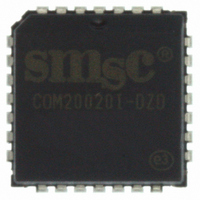COM20020I-DZD SMSC, COM20020I-DZD Datasheet - Page 44

COM20020I-DZD
Manufacturer Part Number
COM20020I-DZD
Description
IC CTRLR LAN UNIV 2KX8 28-PLCC
Manufacturer
SMSC
Series
ARCNETr
Datasheet
1.COM20020I3V-DZD.pdf
(72 pages)
Specifications of COM20020I-DZD
Controller Type
ARCNET Controller
Interface
Differential
Voltage - Supply
4.5 V ~ 5.5 V
Current - Supply
20mA
Operating Temperature
-40°C ~ 85°C
Mounting Type
Surface Mount
Package / Case
28-PLCC
Product
Controller Area Network (CAN)
Number Of Transceivers
1
Data Rate
5 Mbps
Supply Voltage (max)
5.5 V
Supply Voltage (min)
4.5 V
Supply Current (max)
40 mA (Typ)
Maximum Operating Temperature
+ 85 C
Minimum Operating Temperature
- 40 C
Mounting Style
SMD/SMT
Lead Free Status / RoHS Status
Lead free / RoHS Compliant
Other names
638-1001-5
Available stocks
Company
Part Number
Manufacturer
Quantity
Price
Company:
Part Number:
COM20020I-DZD
Manufacturer:
Standard
Quantity:
17 665
Company:
Part Number:
COM20020I-DZD
Manufacturer:
SMSC
Quantity:
269
Company:
Part Number:
COM20020I-DZD
Manufacturer:
Microchip Technology
Quantity:
10 000
Company:
Part Number:
COM20020I-DZD-TR
Manufacturer:
Microchip Technology
Quantity:
10 000
6.4.3
Revision 12-05-06
Receive Sequence
A receive sequence begins with the RI status bit becoming a logic "1", which indicates that a previous
reception has concluded. The microcontroller will be interrupted if the corresponding bit in the Interrupt
Mask Register is set to logic "1". Otherwise, the microcontroller must periodically check the Status
Register. Once the microcontroller is alerted to the fact that the previous reception has concluded, it may
issue the "Enable Receive to Page fnn" command, which resets the RI bit to logic "0" and selects a new
page in the RAM buffer. Again, the appropriate buffer size is specified in the "Define Configuration"
command. Typically, the page which just received the data packet will be read by the microcontroller at
this point. Once the "Enable Receive to Page fnn" command is issued, the microcontroller attends to other
duties. There is no way of knowing how long the new reception will take, since another node may transmit
a packet at any time. When another node does transmit a packet to this node, and if the "Define
Configuration" command has enabled the reception of long packets, the COM20020ID interprets the
packet as either a long or short packet, depending on whether the content of the buffer location 2 is zero or
non-zero. The format of the buffer is shown in Figure 6.3. Address 0 contains the Source Identifier (SID),
Address 1 contains the Destination Identifier (DID), and Address 2 contains, for short packets, the value
256-N, where N represents the message length, or for long packets, the value 0, indicating that it is indeed
a long packet. In the latter case, Address 3 contains the value 512-N, where N represents the message
length. Note that on reception, the COM20020ID deposits packets into the RAM buffer in the same format
that the transmitting node arranges them, which allows for a message to be received and then
retransmitted without rearranging any bytes in the RAM buffer other than the SID and DID. Once the
packet is received and stored correctly in the selected buffer, the COM20020ID sets the RI bit to logic "1"
to signal the microcontroller that the reception is complete.
TRI
TRI
MSB
RI
Figure 6.3 – Command Chaining Status Register Queue
TA
DATASHEET
POR
Page 44
TEST
5Mbps ARCNET (ANSI 878.1) Controller with 2K x 8 On-Chip RAM
RECON
TMA
TMA
SMSC COM20020I Rev D
TTA
TTA
LSB
Datasheet












